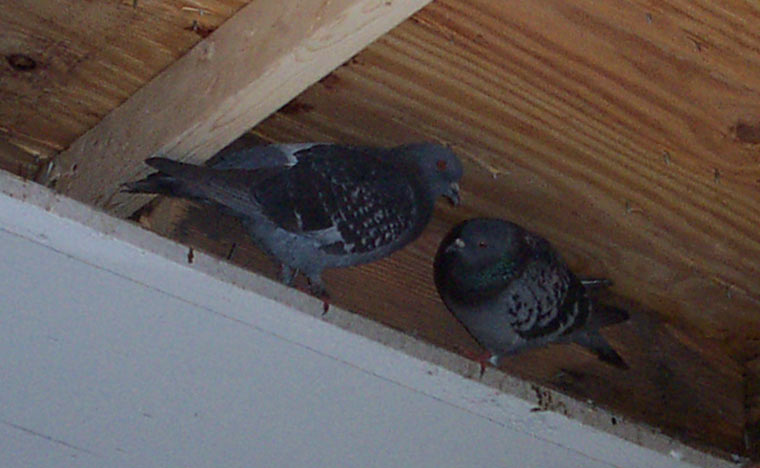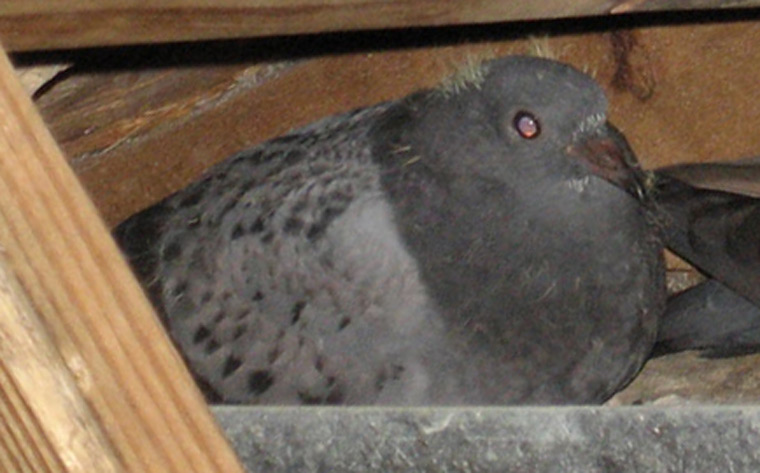-
info@aaanimalcontrol.com
Call us for help in your town
Humane Wildlife Education
Removal of birds from soffit
For those who are homeowners, you have probably
had to deal with birds getting underneath the
eaves or roof of your home in the area that is
commonly referred to as the soffit. This is the
underside of any element of a building which can
also be found over areas like patios, warehouse
structures, or other buildings where there is a
portion that juts out away from the primary
structure itself. This makes it so that there is
an extra area that provide shade or protection
from the elements.

While this may make the building look fancier and
help it to provide protection when it is raining
or excessively hot, it also makes for the perfect
location for a bird to create his home. In fact,
it is quite likely that birds will build a nest
underneath this area directly up against the side
of the house or other building structure. It gives
them the same kind of protection and gives them
relative isolation.
While this may be great for them, that does not
mean that it works for you. Birds who have built a
nest in an area like this will drop their waste
below and make messes on the ground underneath.
This is one of the reasons why this is so
important to get these creatures away. It is not
just that they can make a mess around your home or
business, but that waste can pose a serious health
risk to you, your family, and your customers
should this be in your business. If you are
wanting to know how to remove birds from the
soffit then here are some tips for you.
The first thing that you want to do is to get the
bird to go away. You need some time to put up a
structure that will keep the animal from being
able to return while you are working, and so using
bird fogging is the best option. This is a form of
repellent that you release through a canister that
will cause the bird to go away and tell the
repellent has completely dissipated. It isn't
dangerous to them but is extremely irritating,
meaning it isn't dangerous to you either.
Once the bird is gone, then you can use such
things as bird netting, bird spikes, or other
structures that will help to keep birds from being
able to return to the spot. You also want to make
sure that you completely remove the nest and treat
the area where the nest was at with some form of
repellent to make it even less enticing for the
bird to try to return.
Keep in mind that before taking any of these steps
that it is imperative that you protect your own
health. This means that you should wear gloves,
goggles, and a mask, and cover all exposed areas
of your skin before dealing with anything where
the bird was in contact. This protects you from
getting any kind of bacteria or parasites that
were on the birds.
Removal of Birds from Soffit
Need bird removal in your hometown? We service over 500 USA locations! Click here to hire us in your town and check prices - updated for year 2020.The roof of any building is a commonly attacked spot when birds are on the lookout for a nice, warm and comfortable spot to build their nests. The most common point for these birds to gain access is at the level of the eaves of your home, but holes within fascia boards and soffits can cause the same problem, as could lead that is loose or has become damaged, missing tiles, and also missing cement. These are all spots that you will need to check over if you have already experienced a bird problem.

How to Remove Birds from Soffits
If you already have birds in your soffit, getting rid of them is going to be hard work. We would most definitely recommend calling in the assistance of a professional wildlife removal expert, and particularly one who has experience with birds. There are a great deal of protected birds across the United States, and moving them along, trapping them, and most certainly killing them are all unlawful acts. Before taking any wild animal removal action, even including birds, make sure you check the laws in your local area. The internet is a great place to start looking, but you would always give local wildlife professionals a call. You will find that many of them (including ourselves) will offer you some free advice over the phone, and that advice could prove invaluable when it comes to making sure you don't take part in any accidental illegal activity.
Just for the record, there are a number of birds that are endangered, threatened, or otherwise protected, and the borrowing owl (as one example) is considered a threatened species in places such as Florida and Colorado. In Mexico, the same bird is considered as threatened, and in Canada it is classed as endangered. Birds just like the burrowing owl need to be protected, and that's why we always suggest seeking a professional opinion before going ahead with any removal action.
Birds in your soffit will generally indicate a nest. It is VERY rare to come across birds in soffit, eaves and other places around roofs and buildings that don't have a nest in tow. In order to successfully solve the problem, you are going to need to repair the damaged soffits and bother spots that have allowed the birds to get in, but before you do that, you must remove the birds themselves. This often means the mother and father birds, and also a nest filled with either eggs or babies. Live trapping and releasing of these creatures is often not successful, for a wide variety of reasons:
1 - Relocated birds are able to find their way back 'home' in relatively no time at all. You must remember that many of them will fly several thousand miles in order to migrate to warmer climates for the winter. Flying ten miles to find your home is going to be quicker for the bird than it would be for you to drive home, meaning the problem will already be back by the time you've got back.
2 - Birds experience high levels of stress, and trapping them ALONE can often cause them enough stress to physically harm them. There have been many a story of birds actually dying as a result of stress. You should also remember that these birds are going to flap around frantically when they are worried and panicked, and if they are in a trap or other enclosed space, this could result in them being harmed.
3 - There is a very good chance that, once you have trapped the mother bird, you will be able to find the babies. If they are too young, they won't survive without their mother to feed them, which means they will die in the nest, smelling out your home. This is even more so the case if you happen to have these birds nests in vents, particularly those leading to and from your shower or laundry room / dryers.
By hiring a professional, the birds PLUS their nets will be removed, and the appropriate patches of damage will be sealed and repaired. This gives you your home back, and also ensures the problem doesn't return. A licensed and educated professional will know exactly where these birds like to hide, and they'll also have the right tools and tricks to get them out without harming them.
That's the aim of the game when you have birds or other wild animals in your home. You must first get them out of your home, using whatever means is necessary and legal for that, and then you must seal up whatever holes they use to get in, in the first place. It also must be in that order.
Before you take any bird removal action, make sure you do your research. Is it legal for you to move the birds? What about local and State laws? Are you allowed to use traps? Work out the legalities first, and then make sure you choosing the right and humane option for all parties involved.
For more information, you may want to click on one of these guides that I wrote:
How much does bird removal cost? - get the lowdown on prices.
How to get rid of birds - my main bird removal info guide.
Example bird removal photographs - get do-it-yourself ideas.
Bird job blog - learn from great examples of bird jobs I've done.


















